I am not going to start this review of Maxis’ 2013 reboot of SimCity with a Merriam-Webster definition battle (like a rap battle, but less glamorous) between what constitutes a game and what constitutes a toy, and whether SimCity is the former or the latter. Because it is irrelevant: either way, SimCity shows its shows its pedigree as the city simulator, where the player can raise a polity from vacant field into a sprawling metropolis of hundreds of thousands of people. It is fun and powered by amazing technology, but I would send it back to the drawing room for improvement.
From the Ground Up
Building a sprawling metropolis to rival that of Spokane, Washington is a daunting task. You start humbly, paving a few roads and laying down residential, commercial, and industrial zoning. Within moments, your city will start to come alive with moving trucks bringing in families while taco joints and gas stations sprout up.
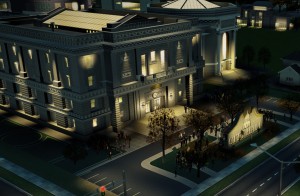
Sims will show up at city hall and protest. They usually don’t show up to tell you what a great job you’re doing.
The RCI zoning will only get you so far though. Pretty soon, your citizens, also known as sims, will begin complaining about not having life’s luxuries, like electricity and running water. Eventually you’ll need to worry about a plethora of issues, including managing parks, police, fire protection, education, sewage, trash collection, mass transit, and health care. The core gameplay is the balancing act between service expenses and tax income. As you satisfy sims’ needs by add utilities and services, you’ll need to find ways of increasing income. Yikes!
Metrospacial Informatics
If all of this sounds a bit overwhelming, or just plain-old tedious, don’t worry: SimCity follows its predecessors and makes the management of all of this data more fun than thumbing through spreadsheets. For every axis of city management, SimCity provides a colorful lens that shows you how you are doing throughout your city. Do you need to know where trash is piling up? There’s a trash view. Where are land values low? There’s a view for that. There is even a view that highlights sims as they go about their day.
As an information professional, I find all of this data to be pretty awesome. And, if you want your city to work like a well-oiled machine, you’ll need to use this information to your advantage.
But is that what you want?
Goals, Unnatural Disasters, and Specializations
All of this data brings up an important aspect of SimCity: it’s a sandbox game with no set victory conditions, so you are free to pursue your own goals and define success in your own way. Maybe success is building the city with the highest population, or maybe a city that is environmentally friendly, a city full of million-dollar mansions, or a city where crime is a memory.
Or maybe you would rather build up a city and watch the whole fall to pieces. If that’s your thing, you can summon earthquakes, start fires, or watch with glee as your city is attacked by a giant fire-breathing lizard. All of this will be familiar to anyone who has fired up any version of SimCity since the original came out in 1989, and I’m pleased to say that destroying a city has never been more fun.
One part of the paradigm that has changed, however, is the inclusion of a new mechanic known as city specializations. The specializations allow you to, well, specialize, your city. For instance, if your plot of land has ore in it, then you might specialize in mining and resource extraction. Doing so will provide significant income and jobs for your sims. This is all well and good, right up to the point when the ore runs dry. As this happens, you will need to pivot your city’s specialization or somehow account for the drop in income. The cost of constructing and operating these specializations is relatively high so you’ll have to choose; your city can’t have everything.
Resources can be bought and sold on the global market, or consumed locally (such as buying coal for a power plant), or used to create a more valuable resource (such as using ore and coal to make metal alloys), or used to help build a Great Work (more on that after a rant about regions).
With a little help from your friends
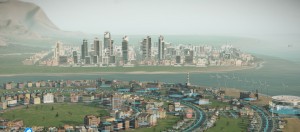
You can see other cities in the same region on the horizon, or even invite yourself over for a visit.
One big difference between this version of SimCity is that your city does not exist in a vacuum. When you first create a game, you actually choose a region in which to play. Each region has up to 16 plots for mayors to build cities. These cities are connected to one another through ferries, trains, and/or highway systems, and sims may live in one city but take the train to another, benefiting both cities in the process.
Cities that are connected can share resources, utilities, offer to share police and fire services, and so forth. Oh, and you can also troll your neighbors by letting crime run rampant in your city and having it spill across your borders or by polluting the heck out of the air and letting it drift toward your “friends”.
I’ll be honest: I was severely disappointed at the way that regions were implemented for a number of reasons.
First, there are only a few regions to pick from, especially if you want to play a big, 16 player game. Whereas other SimCity games the terrain was randomly generated and could be edited by the player (for a cost), here you are limited not only in how the region and its plots are connected, but also the terrain of each city plot. Too many of the plots are, quite literally, a big empty field with a coast on one side or a slight hill. I wish that the players could randomly generate their own regions and plots as this would add a huge amount of replayability.
Second, some of the larger regions have plots that feel like they should be connected to one another, but aren’t. In the first game that I played with three of my friends, we chose plots next to one another on a giant region. To our dismay, it turned out that when my buddy needed to have my police patrol cars help him out during a crime wave, I was not able to send them over because our plots were not directly connected. The game didn’t communicate to me that the plots that we had picked were separated when we picked our plots. At that point, we might as well have been playing in our own games.
Finally, I’ve encountered a number of issues with timing and syncing between cities. Let me explain.
I was playing a game by myself and building up a new city, Pennywise. I decided that this particular city would be high wealth and that I would buy power and water from my neighboring working-class cities, known as The Loop and Carbaton. Everything started out fine. As Pennywise grew, I approached the limit to the amount of utilities that my other cities could provide. So, I hopped over to The Loop and decided to improve its power plant and add more water pumps.
And when I jumped back to Pennywise and waited. And waited. And waited. For whatever reason, the syncing between actions in the cities is not very well refined and is prone to being, well, a pain. In the end, I waited about 15 minutes but could still not get additional power or water from the region that should have been readily available. All the while my rich citizens were complaining that their houses and businesses had no power and water. In the end, I had to build an oil power plant and abandon the vision that I had for my city. Quite a bummer.
Think Big
Great Works are separate from the cities in the region, and once constructed they provide unique benefits to everyone. For instance, one of the Great Works is an international airport, which boosts tourism; another is the arcology, which provides living quarters for a large number of sims.
Getting a Great Work completed is something that I have not yet achieved. However, I like that Maxis included them as it gives me something to strive for as I grow and nurture my cities and gives an incentive to play with friends and to cooperate toward a common goal. I see it as a reward for long-term play and a nice touch.
SimNeighborhood
The simulations in SimCity are quite impressive. Each area will slowly change its wealth and density based upon how educated the sims are, land density, and land values. As a city develops, the buildings slowly change and the whole mood of the city shifts. It’s great fun to see buildings go from 1920s-era factories to 21st century tech parks. It’s pretty cool to see the wide variety of buildings that can spring up.
What makes this process a bit aggravating is that each city plot is rather small, so I kept hitting the edges of my city plot way too quickly. RCI zoning is now free (only requiring a nearby road), and it is easy to fill up the entire city area in a matter of minutes. Even with high density zoning and using every last scrap of land, I have barely crossed the 250,000 sims mark.
I understand that by keeping the city size small, Maxis is forcing you to specialize and manage multiple cities rather than a single metropolis, but as I noted earlier, it’s more like managing Spokane than managing Los Angeles. Also, with the issues I had with sharing resources among my cities and frankly, it just feels like a cop out.
Also, there is the fact that because land is so precious, virtually all of my cities end up using every single scrap of it. And having skyscrapers next to the border of the city just doesn’t look right at all. I wish that the base size of the city was much bigger (4x the size would be a good start), or that the player could spend money to purchase nearby land to extend the city. I think that I would feel a much closer connection to my cities if I spent more time with each one, rather than abandoning them after only a few hours of gameplay to start on a new plot in the same region.
Always Online
One thing that drives me nuts about the game is that the game part of it is fairly well done, but I really do not understand the always online requirement. While Maxis may say that it was a design decision and that money had nothing to do with it, I think it’s fair to say that that’s a load of crap.
While having a global economy for trading resources is interesting, I highly doubt that my personal game experience would be much different if a.) the prices were fixed and calculated locally instead, and a global economy was simulated; or b.) the values were updated when I have access to the Internet, but the game doesn’t turn off if my wireless flutters.
Forcing players to stay online also brought about a rather terrible launch. While I bought the game a few days after release, I was unable to play for several hours early into owning the game. EA did offer a free game as a show of good faith (Dead Space 3 review incoming!), but I’d rather have had their CEO announce that Origin will now be optional and no EA future game will have always online DRM.
Also, as an information professional and someone concerned about game history, I have to say that SimCity is likely going to be a game that is killed early and lost forever. Because the GlassBox engine itself requires server-side processing, I would not be surprised if this game is completely dead and unplayable within ten years. Some of the computations appear to be able to happen locally, but it is unclear whether the game functions for extended periods of time without the global servers operational.
While it may sound like a long time, in the grand scheme of things, 2023 it is nothing. I frequently go back and play old RPGs and DOS games from the early 1990s, but I highly doubt SimCity will be a game that I come back to. Not because the game isn’t enjoyable, because it is, but because someone else will decide to pull the plug, and there will be little that anyone else can do about it.
It was for this reason alone that I hesitated when deciding to buy the game. It looked great and received generally positive reviews, but I felt bad when I caved and purchased it, because I do not believe that this model is the way forward.
Designer Skyline in My Head
I want to really like the new SimCity. But I can’t give it a hearty endorsement when decisions made at the upper echelons of command prevent the game from being great, and I would rather manage a sprawling metropolis than a single neighborhood. I think the core mechanics are solid and it’s just beautiful to play. However, I fear for its longevity and do not think that it will stand the test of time.
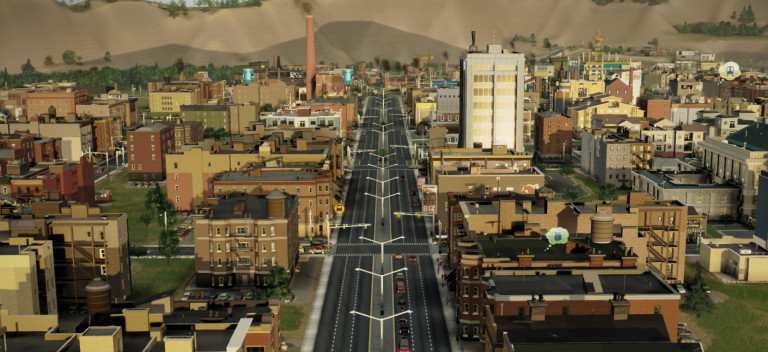
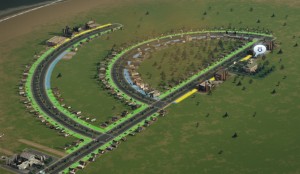
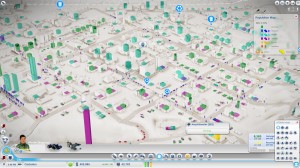

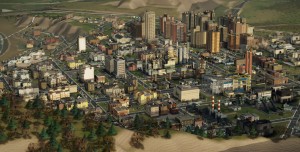

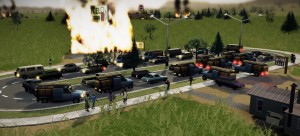
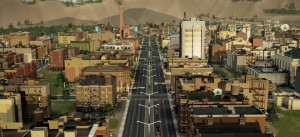
Comments